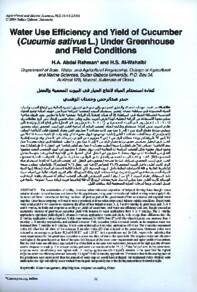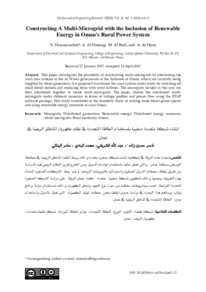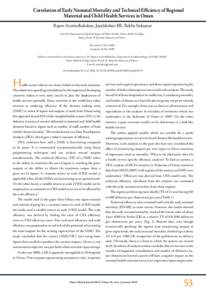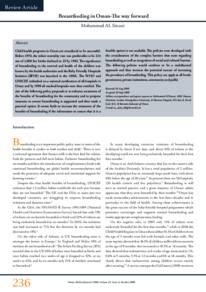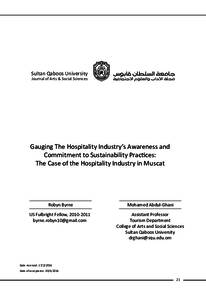Document
Water use efficiency and yield of cucumber (cucumis sativus L.) under greenhouse and field conditions.
Contributors
Al-Wahaibi, H.S., Author
Publisher
Sultan Qaboos university
Gregorian
2004
Language
English
English abstract
The combination of aridity, cxtensive urbanization and expansion of irigatod farming have brought about substantial water demand increase and intensified the gap between rising water demands and limited existing water supply in the Sultanate of Oman. Greenhouse faming has been adopted as part of the govermment efforts to conserve and augment water supplies. Greenhouse cropping in Oman is mostly practiced at times when crops could tolerate outside conditions. Experiments were conducted for two seasons to determine the effect of four imigation rates (1, 2, 3 and 4 mm/day in greenhouse and 3, 4, 6 and 8 mm/day in field) and evaporative cooling on yields of cucumbers, total water use efficiency and cost. Results showed an asymptotic increase of greenhouse cucumber yield with increase in water applications from 1 to 4 mm/day. The 2 mm/day applications optimized yields (kg/m3), whereas 3 mm/day applications maximized yields, with no significant difference from the 2 mm/day applications being observed. Yields were increased by 135% from 27 to 63 t/ha when irigation was increased from l mm/day to 3 mm/day respectively, and declined therafter. Field cucumber yields increased linearly as the irigation water was increased from 3 mm/day to 8 mm/day. Yields were optimized at 6 mm/day applications (35 t/ha). The 8 mm/day maximized yields (40 t/ha) but fell short of the optimum 2 mm/day yields (53 t/ha) obtained in the greenhouse. Optimum yields were obtained at an average crop factor (K.) of 0.58 ET, and 1.55 ET, in the greenhouse and the field respectively, indicating that water requirements for the groenhouse cucumber is about one third of that in the open field. The imigation water Use efficiency was higher in the greenhouse than that of the open field because of the lower water requirements and higher yields of cucumbers. But the total water use efliciency approached that of the field as the rates were maximized, because of the high quantity of water used in evaporative cooling. The average cooling pad water use was found to be 79.1 1 m-2 day-1 of pad area. In the greenhouse, imigation water use efficiency was highest with 2 mmday applications (31.3 kg/m3), whereas in the open field the highest imigation water use efficiency obtained was only 7.6 kg/m3 tor the 6 mm/day applications. Treatments close to the cooling pads of the greenhouse were more moist than the amount of water applied would have indicated, but suppressod yields obtained were attributed to the high soil salinity levels washed from the pads and possibly due to the chilling temperatures incurred at night.
Member of
ISSN
2410-1079
Resource URL
Citation
Abdel Rahman, H. A., & Al-Wahaibi, H. S. (2004). Water use efficiency and yield of cucumber (cucumis sativus L.) under greenhouse and field conditions. Journal of Agricultural and Marian Sciences, 9 (2), 31-41.
Arabic abstract
ساهمت موجات الجفاف والتطور العمراني والزراعي في تعميق الفجوة المائية بين ارتفاع الطلب وكميات المياه المحدودة في سلطنة عمان. ويعتبر استخدام البيوت المحبة للزراعة جزءا من جهود الدولة لوضع الحلول المناسبة لمشكلة المياه في السلطنة، إلا أن هناك اعتقادا بأن الزراعة المحمية غالبا ما تمارس تحت ظروف مناخية يمكن معها الاستفادة من الزراعة الحقلية. لهذا الغرض أجريت تجارب وعلى مدى عاميين لإيجاد تأثير أربعة معاملات ري (1، 2، 3، 4 مم/ يوم في البيت المحمي) و ( 3، 4، 6، 8 مم/ يوم في الحقل) على إنتاج الخيار ودراسة تأثير نظام التبريد على كفاءة استخدام وتكاليف المياه. أوضحت النتائج أن إنتاجية الخيار في البيت المحمي تتزايد بمنحنى تربيعي بزيادة معدل الري من 1 إلى 4 مم/ يوم. كانت معدلات 2 مم/ يوم أفضل معدل للحصول على الإنتاجية المثلى (كجم / متر3) ، بينما أعطت معدلات 3 أعلى إنتاجية دون وجود فروق معنوية تذكر. ولقد زادت الإنتاجية بنسبة 135% من 27 إلى 63 طن /هكتار بزيادة معدلات الري من 1 إلى 3 مم/ يوم على التوالي، ثم بدأت في الانحدار. وقد تزايدت إنتاجية الخيار في الحقل بمنحني خطي بزيادة معدل الري من 3 إلى 8 مم/ يوم، وأعطت المعاملة التي تروى بمعدل 6 مم/ يوم الإنتاجية المثلى ( 35 طن /هكتار) بينما أعطت معدلات 8 مم/ يوم أعلى إنتاجية في الحقل (40 طن / هكتار) دون وجود فروق معنوية تذكر. أوضحت الدراسة أن المعاملة التي تروى بمعدل 2 مم/ يوم في البيت المحمي أنتجت محصولا أفضل من المعاملة التي تروى بمعدل 8 مم/ يوم في الحقل. أمكن الحصول على الإنتاجية المثلى عند متوسط معامل المحصول (kc) 0.58 و1.55 للبيت المحمي والحقل على التوالي، مما يدل على أن الاحتياجات المائية لمحصول الخيار في البيت المحمي تساوي ثلث ما يحتاجه المحصول في الحقل. كما أوضحت الدراسة أن كفاءة استخدام مياه الري كانت أعلى داخل البيت المحمي (31.3 كجم / متر3) عنه في الحقل ( 7.6 كجم / متر3) للإنتاجيات المثلى، نتيجة الإنتاجية العالية وقلة الاحتياجات المائية داخل البيوت المحمية. لكن الكفاءة الكلية لاستخدام المياه (مضافا إليها كمية المياه المستخدمة في التبريد) تقاربت بزيادة معدلات الري وذلك لاستهلاك نظام التبريد كميات عالية من المياه، حيث بلع استهلاك نظام التبريد 79.1 لتر/ يوم/ للمتر المربع من الوسائد. أوضحت النتائج أن مستوى رطوبة التربة قرب الوسائد كانت أعلى مما يمكن أن تدل عليه معدلات الري إلا أن قلة إنتاجيتها عزيت لزيادة نسبة الملوحة الناتجة عن غسل الوسائد وربما لدرجات الحرارة المختصة أثناء ساعات الليل.
Category
Journal articles

